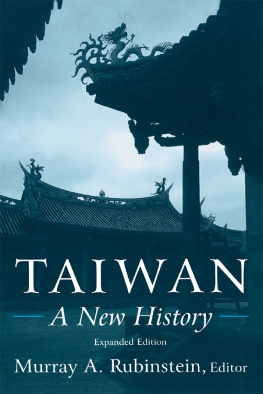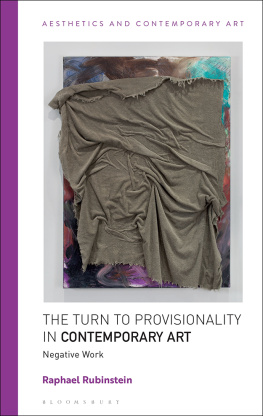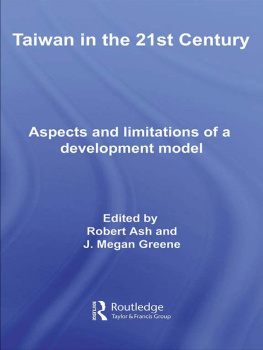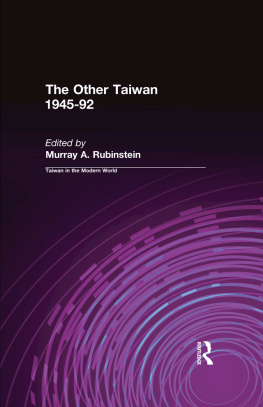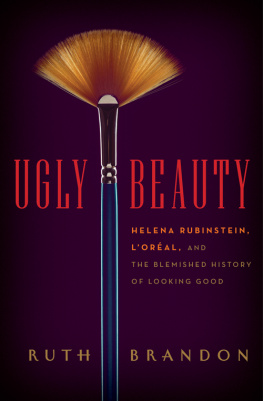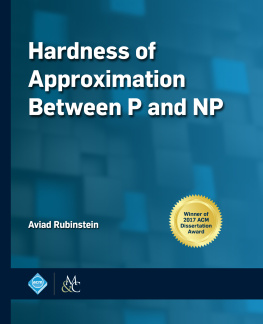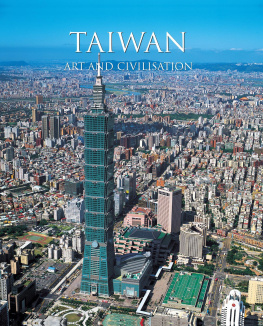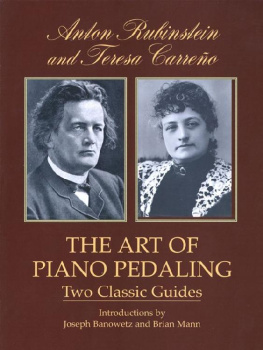Rubinstein - Taiwan: A New History
Here you can read online Rubinstein - Taiwan: A New History full text of the book (entire story) in english for free. Download pdf and epub, get meaning, cover and reviews about this ebook. City: Taiwan, year: 2015, publisher: Taylor & Francis (CAM);Routledge, genre: Home and family. Description of the work, (preface) as well as reviews are available. Best literature library LitArk.com created for fans of good reading and offers a wide selection of genres:
Romance novel
Science fiction
Adventure
Detective
Science
History
Home and family
Prose
Art
Politics
Computer
Non-fiction
Religion
Business
Children
Humor
Choose a favorite category and find really read worthwhile books. Enjoy immersion in the world of imagination, feel the emotions of the characters or learn something new for yourself, make an fascinating discovery.
- Book:Taiwan: A New History
- Author:
- Publisher:Taylor & Francis (CAM);Routledge
- Genre:
- Year:2015
- City:Taiwan
- Rating:3 / 5
- Favourites:Add to favourites
- Your mark:
- 60
- 1
- 2
- 3
- 4
- 5
Taiwan: A New History: summary, description and annotation
We offer to read an annotation, description, summary or preface (depends on what the author of the book "Taiwan: A New History" wrote himself). If you haven't found the necessary information about the book — write in the comments, we will try to find it.
Taiwan: A New History — read online for free the complete book (whole text) full work
Below is the text of the book, divided by pages. System saving the place of the last page read, allows you to conveniently read the book "Taiwan: A New History" online for free, without having to search again every time where you left off. Put a bookmark, and you can go to the page where you finished reading at any time.
Font size:
Interval:
Bookmark:
A New History
Expanded Edition
Murray A. Rubinstein, Editor



An East Gate Book
First published 2007 by M.E. Sharpe
Published 2015 by Routledge
2 Park Square, Milton Park, Abingdon, Oxon OX14 4RN
711 Third Avenue, New York, NY 10017, USA
Routledge is an imprint of the Taylor & Francis Group, an informa business
Copyright 1999, 2007 Taylor & Francis. All rights reserved.
No part of this book may be reprinted or reproduced or utilised in any form or by any electronic, mechanical, or other means, now known or hereafter invented, including photocopying and recording, or in any information storage or retrieval system, without permission in writing from the publishers.
Notices
No responsibility is assumed by the publisher for any injury and/or damage to persons or property as a matter of products liability, negligence or otherwise, or from any use of operation of any methods, products, instructions or ideas contained in the material herein.
Practitioners and researchers must always rely on their own experience and knowledge in evaluating and using any information, methods, compounds, or experiments described herein. In using such information or methods they should be mindful of their own safety and the safety of others, including parties for whom they have a professional responsibility.
Product or corporate names may be trademarks or registered trademarks, and are used only for identification and explanation without intent to infringe.
Library of Congress Cataloging-in-Publication Data
Taiwan : a new history, expanded edition/edited by Murray A. Rubinstein.
p. cm.
An East Gate book.
Includes index.
ISBN-10: 0-7656-1494-4 (cloth : alk. paper); ISBN-13: 978-0-7656-1494-0 (cloth : alk paper)
ISBN-10: 0-7656-1495-2 (pbk.: alk. paper); ISBN-13: 978-0-7656-1495-7 (pbk.: alk. paper)
1. TaiwanHistory. I. Rubinstein, Murray, A., 1942
| DS799.5.T3114 2006 951.24905dc22 | 2006047234 |
ISBN 13: 9780765614957 (pbk)
ISBN 13: 9780765614940 (hbk)
Much has happened in Taiwan since the first edition of this book appeared in 1999. The narrative of the first edition ended in late 1996, seven months after the second inauguration of President Lee Teng-hui and Vice President Lien Chan. Lee, then a member of the Kuomintang, was the first popularly elected president to take power in the history of the Republic of China, an event singular in its significance. Yet Lee was also a lame duck and began making the mistakes that lame ducks often make in their attempts to forestall their loss of real and effective power. In this edition, that original postscript has become, in the able hands of Cal Clark, a full-scale chapter that covers the events of Lees second term as well as the first term and subsequent reelection of Chen Shui-bian of the Democratic Progressive Party.
I would like to thank my fourteen co-authors and my editors, Doug Merwin, now head of his own press, East Bridge, and Patricia Loo editor of Asian Studies at M.E. Sharpe. I must also thank those at M.E. Sharpe, Inc. for inaugurating and continuing to publish the series Taiwan in the Modern World.
I am happy to report that the first edition has been embraced by the critics in the major journals and widely adopted for teaching purposes. I hope that this second edition will do even more by serving as a starting point for future research and stimulating new students to pursue further research on the history of Taiwan as it moves into the twenty-first century.
Murray A. Rubinstein
Taiwans past is encountered wherever one travels on this small, crowded, and, perhaps, overdeveloped island. To understand the dramatic and sometimes chaotic chronicle that is Taiwans history, one must first gain some sense of place and some appreciation for how geography helped to define this islands multilayered pastfrom sites that reflect the islands present, on to places that reflect the dawn of the islands written history as home of Australasian immigrants, as new-found home of land-hungry southeastern Chinese settlers, and as one of the two island frontiers of imperial China.
Taipei is the heart of this modern Taiwan, the islands bustling, traffic-clogged, major city, which hosts the national government of this political entity dominated by the Nationalist Party (KuomintangKMT) that continues to call itself the Republic of China (ROC). There are located the governments executive offices, cabinet ministries, legislative assemblies, highest courts, and examination and control branches. Here are also the homes of the islands major electronic media, three government-dominated television stations, and the major newspapers. Here, too, in the city and its nearby suburbs are three of the islands major public universities: National Taiwan University (Tai-ta), Taiwan Political Affairs University (Cheng-ta), and Taiwan Normal University (Shih-ta). The city also serves as a cultural hub. Thus the major museumsthe world-renowned Palace Museum, the Museum of History, and the Taipei Museum of Modern Artare in or near the city. The states two largest memorials cum cultural centers, the performance halls of Chiang Kai-shek Memorial and the Sun Yat-sen Memorial Hall are, respectively, in the citys governmental and financial districts.
The sprawling city and suburbs that make up the Taipei special administrative district are both the center of national development and the stronghold of the ethnic mainlander (wai-sheng jen) population that still dominates the organs of the central government. Taipei thus can be seen as a city approaching the world-class status that befits the hub of a state that is a small, but still dynamic, East Asian economic and political power center. Another, and in many ways very different, Taiwan can be found to the south of this increasingly sophisticated city.
Our journey into Taiwans past begins here in Taipei, at the front gate of the park that houses the Chiang Kai-shek Memorial. In March 1990 this gate and the steps of a nearby theater were the site of a dramatic sit-in staged by students of the ROCs major universities. These students were demanding political change and, following in the footsteps of Peking University students at Tiananmen Square ten months before, attempting to pressure their government and induce it to promise constructive reforms. Conscious of the events in Beijing (Peking), and well aware of the worldwide reaction to these events, the regime leaders remained calm and, through an intermediary, negotiated a peaceful settlement with the students. This settlement paved the way for the formation of the National Consultative Assembly. This meeting, held early in the summer of 1990, brought together people of diverse backgrounds and opinions and promoted the discussion of many of the major political problems that faced Taiwan as it attempted to democratize.
Just to the south and west of Taipeis urban core lies the suburb of Panchiao. Here, amid the choking sprawl that is typical of the nearby suburbs of Taipei and the other large cities of the island, is a large square block that is a refuge from the crowded neighborhood. It is surrounded by a window to the quieter times when Taiwan was a prefecture of the Ching empire: the walled complex that was the home of the Lins, one of the two large and powerful landlord/gentry families that shared the same surname. The estate, once neglected, has been refurbished, and visitors can obtain a published guide to the buildings, gardens, and pavilions of the complex. Wandering through these grounds, one can tune out the modern city and imagine the world in which these gentry on the Ching maritime frontier lived.
Font size:
Interval:
Bookmark:
Similar books «Taiwan: A New History»
Look at similar books to Taiwan: A New History. We have selected literature similar in name and meaning in the hope of providing readers with more options to find new, interesting, not yet read works.
Discussion, reviews of the book Taiwan: A New History and just readers' own opinions. Leave your comments, write what you think about the work, its meaning or the main characters. Specify what exactly you liked and what you didn't like, and why you think so.

